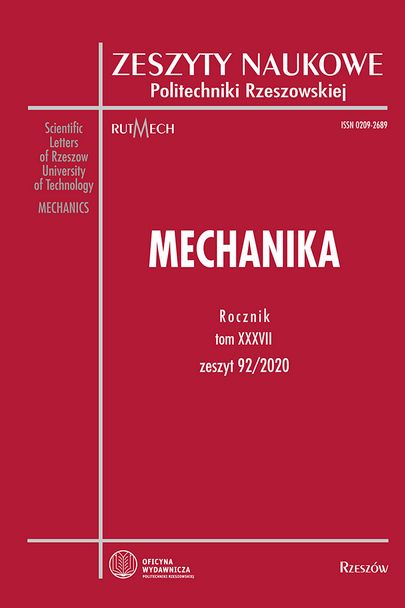Abstract
Airplanes structures are exposed to various load condition components in flight. Each task in flight consists of a series of maneuvers that generate different loads on the aircraft, both in terms of value and direction of action. A high level of durability and reliability is a basic, strict requirement for modern aircraft structures. This means that many, often conflicting limitations must be taken into account when designing an aircraft. The most important of them is the mass of the structure, which has a decisive impact on both flight and technical properties, as well as the economy of operation. This makes the plane one of the most complex technical products. Modern aircraft structures, or more precisely their load-bearing elements, are almost exclusively thin-walled, which meet the postulate of minimizing the weight of the structure. Systems in which the covering is reinforced with longitudinal and transverse elements are widely used, ensuring the required stiffness and strength of the entire system. While the local loss of stability of the roofing is acceptable under working load conditions, exceeding the critical load levels of structural framing members (frames, stringers, frames) practically amounts to the failure of the structure. The indicated factors force the continuous improvement of both design methods and construction solutions in aviation. The development of materials engineering and the continuous improvement of technological processes are not without significance for the effectiveness of these ideas. These disciplines allow for the construction of geometrically complex integral structures that make it possible not only to use the material properties more rationally, but also, through their appropriate shaping, significantly increase the permissible loads on the load-bearing structure. The main advantage in the design of integral parts is the economic savings achieved by eliminating or reducing assembly operations. Densely ribbed roofing elements made in this technology are elements of the load-bearing structure that reduce the weight and increase the strength parameters of the load-bearing structure. By reducing the thickness of the coating and at the same time introducing densely stiffening longitudinal members, it is possible to obtain a structure with much higher critical loads and, consequently, a more favorable distribution of gradients and stress levels, which directly contributes to increasing the fatigue life. The article attempts to evaluate the introduction of new airframe construction technologies to increase their strength, aerodynamic and mass values.
References
Brzoska Z., Statyka i stateczność konstrukcji prętowych i cienkościennych, PWN, Warszawa 1965.
Fellipa C.A., Introduction to finie element methods, Dep. of Aerospace Eng. Sci. Bouilder, Colorado 2006.
Fellipa C.A., Nonlinear finite element methods, Dep. of Aerospace Eng. Sci. Bouilder, Colorado 2001.
Kopecki T., Stany zaawansowanych deformacji w projektowaniu cienkościennych ustrojów nośnych, Oficyna Wydawnicza PRz, Rzeszów 2010.
Kopkowicz M., Wytrzymałość materiałów. Laboratorium, Oficyna Wydawnicza PRz, Rzeszów 2006.
Lundblad M., Influence of Cutting Tool Geometry on Residual Stress in the Workpiece, Proc. Third Wave Advant Edge User’s Conferece, Atlanta, GA, Paper 7(2002).
Shet C., Deng X., Residual Stresses and Strains in Orthogonal Metal Cutting, Int. J. Machine Tools Manuf., 43/6(2003), 573-587.
Kuczmaszewski J., Pieśko P., Zawada-Michałowska M., Influence of Milling Strategies of Thin-walled Elements on Effectiveness of their Manufacturing, Procedia Engineering (2017), 182:381-186.
Adamski W., Manufacturing development strategies in aviation industry, Advances in Manufacturing Science and Technology, Vol. 34, nr 3(2010), 73-84.
Bałon P., Szostak J., Kiełbasa B., Rejman E., Smusz R., „Application of High Speed Machining Technology in Aviation”, 21st International ESAFORM Conference on Material Forming (2018).
Bałon P., Rejman E., Smusz R., Szostak J., Kiełbasa B., „High Speed Milling in thin-walled aircraft structures”, Applied Computer Science, Vol. 14, nr 2(2018), pp. 82-95.
Shih A.J., Yang H.T.Y., Experimental and Finite Element Predictions of Residual Stresses Due to Orthogonal Metal Cutting, Int. J. Num. Meth. Eng., 36(1993), 1487-1507.
Mativenga P.T., Hon K.K.B., An experimental study of cutting force in high speed end milling and implications for dynamic force modelling, Journal of Manufacturing Science and Engineering, 127, 2(2005), 251-261.
Adamski W., Wpływ nowych technik wytwarzania na konstrukcję samolotu, Mechanika, nr 12(2015).
Włodarczyk M., Analiza wpływu sił skrawania oraz zamocowania na poziom naprężeń w aspekcie grubości ścianek wybranej konstrukcji kieszeniowej, Postępy Nauki i Techniki, nr 8(2011) Politechnika Lubelska.


